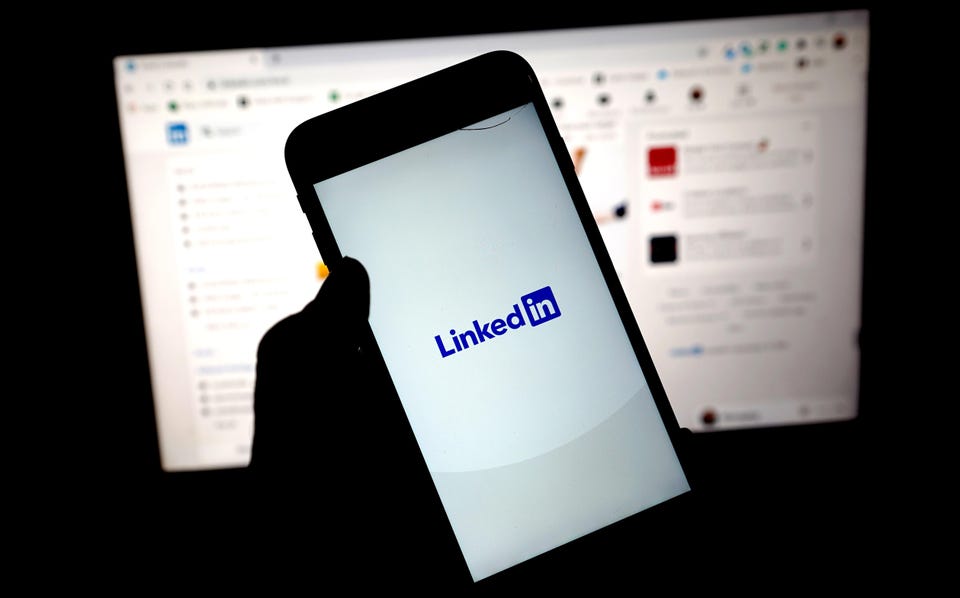Cybersecurity LinkedIn Wants To Help Users Detect And Report Fake Accounts Emma Woollacott Senior Contributor Opinions expressed by Forbes Contributors are their own. Following New! Follow this author to stay notified about their latest stories. Got it! Oct 27, 2022, 04:38am EDT | New! Click on the conversation bubble to join the conversation Got it! Share to Facebook Share to Twitter Share to Linkedin The LinkedIn app on a mobile phone.
(Photo by Edward Smith/Getty Images) Getty Images Following reports that LinkedIn has been plagued by fake accounts, the company is cracking down with new features aimed at helping users work out if a profile is genuine. The company is adding a new ‘About this profile’ feature, showing when it was created and last updated, along with whether the member has verified a phone number and/or work email associated with their account. “We hope that viewing this information will help you make informed decisions, such as when you are deciding whether to accept a connection request or reply to a message,” says vice president of product management Oscar Rodriguez.
The feature will appear on every profile from this week, with companies to be added over time. Fake accounts frequently have fake photos, generated using AI, and often completely convincing. Now, says Rodriguez, a new deep-learning-based model will proactively evaluate profile photo uploads, looking for subtle image artifacts associated with the AI-based synthetic image generation process.
It won’t, he says, carry out any facial recognition or biometric analyses. And the site will also flag messages that include high-risk content. “We may warn you about messages that ask you to take the conversation to another platform because that can be a sign of a scam,” says Rodruigez.
“These warnings will also give you the choice to report the content without letting the sender know. ” The changes follow reports over the last few months that the site has become flooded with fake profiles. Late last month, for example, cybercrime expert Brian Krebs reported that a large number of fake LinkedIn profiles for chief information security officers at some of the world’s largest corporations were appearing on the site.
MORE FOR YOU The ‘Backsies’ Billionaire: Texan Builds Second Fortune From Wreckage Of Real Estate Empire He’d Sold Young Pakistani Filmmaker Keeps An Eye On Climate Change That New ‘Armored Core 4’ Action Figure Has An Eye Watering Price Tag “We don’t know much about who or what is behind these profiles, but in August the security firm Mandiant (recently acquired by Google) told Bloomberg that hackers working for the North Korean government have been copying resumes and profiles from leading job listing platforms LinkedIn and Indeed, as part of an elaborate scheme to land jobs at cryptocurrency firms,” he wrote. In other cases, says Rachel Jones, CEO of SnapDragon Monitoring, the fake profiles are being used for more common scams. “These scams range from criminals setting up fake profiles and advertising the sales of fake counterfeit goods, which can endanger people’s lives, to monetary scams where fraudsters set up spoofs of legitimate websites, advertise them on social media, and then con people into visiting them and handing over their financial information,” she says.
“Furthermore, criminals also use social media to lure people into romance scams, or even to set up fake profiles pretending to be recruiters for legitimate organizations. ” Rodriguez says that the vast majority of fake accounts are detected by its automated systems before they ever go live, and that the company is working to improve them. Follow me on Twitter .
Emma Woollacott Editorial Standards Print Reprints & Permissions.
From: forbes
URL: https://www.forbes.com/sites/emmawoollacott/2022/10/27/linkedin-wants-to-help-users-detect-and-report-fake-accounts/



